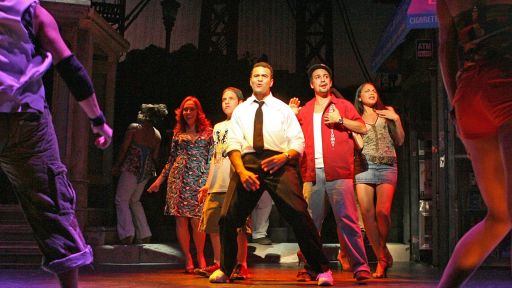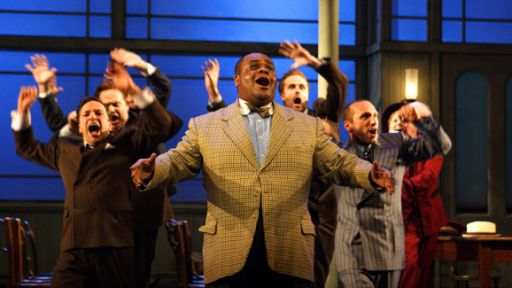
Joe Sinnott-Thirteen/WNET New York
The year 1949 found Richard Rodgers and Oscar Hammerstein at a crossroads in their collaboration. They had enjoyed outstanding success together with “Oklahoma!” (1943) and “Carousel” (1945) on stage and with STATE FAIR (1945) on the screen, but they had stumbled awkwardly with “Allegro” (1947) on Broadway. The ambitious, experimental work had much to recommend it, but Hammerstein’s original book was too scattered to satisfy audiences and critics. The team needed to reestablish their reputation as Broadway’s premiere creators of the musical play. James Michener’s series of World War II stories titled “Tales of the South Pacific” seemed like an ideal vehicle, rich with distinctive characters, exotic locales, and potent themes. Yet “South Pacific” would break away from the established Rodgers and Hammerstein model in many ways.
First of all, the team was known for re-creating Americana on stage. These tales were set in a foreign land and, while most of the characters were American, they were reacting to situations that were far from homespun. Second, Hammerstein was an expert at dramatizing novels and plays for the musical stage, but Michener’s book consisted of short stories, not one of which could sustain a full-length musical drama by itself. But Hammerstein rose to the occasion and, working closely with co-librettist and director Joshua Logan, took characters and plots from three of the stories and fashioned them into a coherent, unified libretto. Another anomaly about “South Pacific” is that it was the first (and one of the few) Rodgers and Hammerstein musicals written for established stars. Although their previous Broadway efforts had helped launch the careers of Alfred Drake, Celeste Holm, John Raitt, and Lisa Kirk, those earlier musicals featured no names above the title. The musical itself was the star. But “South Pacific” was written and composed with Broadway belter Mary Martin and Metropolitan Opera bass Ezio Pinza specifically in mind. The pairing of two such voices was so unusual in Broadway tradition that the writers wisely kept the two stars from singing simultaneously until close to the end of the first act, figuring that audiences would accept the combination once they were involved with the stars as characters and not merely as singers. The captivating duet “Twin Soliloquies” early in the show is simply that: two separate solos that alternate, giving the illusion of a rhapsodic operetta duet without any vocal overlapping.
But of all the challenges facing Rodgers and Hammerstein in their new venture, the most daunting was theme. Racial prejudice had only rarely been the issue in a Broadway musical. Jerome Kern’s and Hammerstein’s “Show Boat” (1927) evoked the plight of African Americans in the post-Civil War South, the Gershwins tackled similar themes in “Porgy and Bess” (1935), and E. Y. Harburg, Fred Saidy, and associates took on slavery and segregation in their mocking Civil War musical “Bloomer Girl” (1944) and their satiric fantasy “Finian’s Rainbow” (1947). While the ache of prejudice and oppression served as the background for these musicals, it was central in “South Pacific.” Consider the fact that this was the first Rodgers and Hammerstein musical with no villain of any kind. The world is at war and there is conflict all around, but one cannot say that the real enemy in “South Pacific” is the Japanese military. No character in the musical attempts to harm, hinder, or provoke any other character. Yet, all dramas need a protagonist and an antagonist. “South Pacific” is no exception, but the conflicts in this musical are internal. The deep-seated prejudice that lies within nurse Nellie Forbush and Lieutenant Joe Cable provide the complications. These two are threatened by no one but their own prejudices, fears, and traditional way of thinking. “South Pacific” is the first (and remains one of the very few) musicals to draw its emotional power not merely from a love story, but from a cruel, unbending inner doubt.
While Nellie and Cable are both Americans, each caught in a romance with a foreign and questionable love, they suffer from different kinds of prejudice. Nellie comes from the segregated South; a spunky Arkansas girl, she is not highly educated, but is not afraid to be thought of as different. One reason she left home and got involved in the war was her discontent with the narrow-minded view of the world that surrounded her. The other nurses tease her for her “cockeyed” optimism, and she seems game for ‘most any adventure. Falling in love with the eloquent, sophisticated French planter Emile de Becque is an adventure, and her only doubts about the romance come from wondering what such an intelligent gent sees in a “little hick” like herself. But when she finds out about Emile’s previous marriage and is confronted with the idea that she might be stepmother to two Polynesian children, the adventure becomes too rough and her Arkansas background kicks in. Her overriding love for Emile (especially when she fears that he has died on the dangerous mission she drove him to) helps her conquer her prejudices. Cable, on the other hand, is a college-educated Northerner from a wealthy family and has a pretty good sense about how the world operates. He should, one would think, be more prepared to deal with prejudice. After all, he is no hick; he is the enlightened American, dedicated to a cause, selfless in his outlook, and willing to die for something important. Yet he cannot see himself breaking with his Philadelphia Main Line fiancée and returning to America with a Polynesian wife. That takes too much courage, even for a war hero. Cable, in the musical’s most potent and bitter song, argues that “You’ve Got to Be Carefully Taught” to carry on your ancestors’ prejudice. He can describe, calculate, and even explain his prejudice; what he cannot do is overcome it until it’s too late.
The theme of prejudice in “South Pacific” is not subtle and was not meant to be merely suggested or mildly alluded to. During final rehearsals, some acquaintances of the collaborators suggested to Rodgers and Hammerstein that “You’ve Got to Be Carefully Taught” be cut, fearing that it might turn off or even antagonize audiences. Hammerstein said they might as well cancel the whole production if safe complacency was the goal. The song remained in the show and yes, it did (and still does) turn off and even antagonize some spectators. During the first national tour, “South Pacific” ran into trouble from locals over the song and the show had to avoid cities where its deletion was required. Although the lack of racial tolerance in the musical is about Asians, its pertinence to all kinds of prejudice was not lost on anyone.
Today, some like to dismiss Rodgers and Hammerstein’s handling of such difficult issues in “South Pacific” as simplistic. Nellie overcomes her doubts and ends up with Emile; Cable cannot conquer his and he dies. Is that begging the question or just finding a dramatic way of saying something potent within the framework of a musical entertainment? We like to pride ourselves on believing we are more tolerant and see the issues of race with a more complex understanding today. But how many of us would have had the courage to do in 1949 what Rodgers and Hammerstein did in “South Pacific”?
–Thomas Hischak







